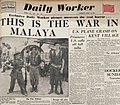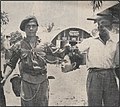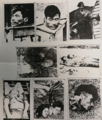Headhunting
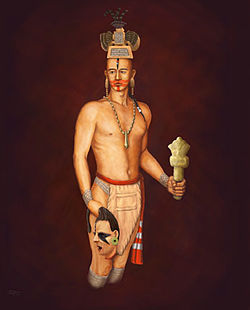
Headhunting is the practice of hunting a human and collecting the severed head after killing the victim, although sometimes more portable body parts (such as ear, nose, or scalp) are taken instead as trophies. Headhunting was practiced in historic times in parts of Europe, East Asia, Oceania, Southeast Asia, South Asia, Mesoamerica, South America, West Africa, and Central Africa.
The headhunting practice has been the subject of intense study within the anthropological community, where scholars try to assess and interpret its social roles, functions, and motivations. Anthropological writings explore themes in headhunting that include mortification of the rival, ritual violence, cosmological balance, the display of manhood, cannibalism, dominance over the body and soul of his enemies in life and afterlife, as a trophy and proof of killing (achievement in hunting), show of greatness, prestige by taking on a rival's spirit and power, and as a means of securing the services of the victim as a slave in the afterlife.[1]
Today's scholars generally agree that headhunting's primary function was ritual and ceremonial. It was part of the process of structuring, reinforcing, and defending hierarchical relationships between communities and individuals.[citation needed] Some experts theorize that the practice stemmed from the belief that the head contained "soul matter" or life force, which could be harnessed through its capture.[2]
Austronesia
[edit]
Among the various Austronesian peoples, head-hunting raids were strongly tied to the practice of tattooing. In head-hunting societies, tattoos were records of how many heads the warriors had taken in battle, and was part of the initiation rites into adulthood. The number and location of tattoos, therefore, were indicative of a warrior's status and prowess.[3]
Indonesia and Malaysia
[edit]In Southeast Asia, anthropological writings have explored headhunting and other practices of the Murut, Dusun Lotud, Iban, Berawan, Wana and Mappurondo tribes. Among these groups, headhunting was usually a ritual activity rather than an act of war or feuding. A warrior would take a single head. Headhunting acted as a catalyst for the cessation of personal and collective mourning for the community's dead. Ideas of manhood and marriage were encompassed in the practice, and the taken heads were highly prized. Other reasons for headhunting included capture of enemies as slaves, looting of valuable properties, intra and inter-ethnic conflicts, and territorial expansion.
Italian anthropologist and explorer Elio Modigliani visited the headhunting communities in South Nias (an island to the west of Sumatra) in 1886; he wrote a detailed study of their society and beliefs. He found that the main purpose of headhunting was the belief that, if a man owned another person's skull, his victim would serve as a slave of the owner for eternity in the afterlife. Human skulls were a valuable commodity.[1] Sporadic headhunting continued in Nias island until the late 20th century, the last reported incident dating from 1998.[4]
Headhunting was practiced among Sumba people until the early 20th century. It was done only in large war parties. When the men hunted wild animals, by contrast, they operated in silence and secrecy.[5] The skulls collected were hung on the skull tree erected in the center of village.
Kenneth George wrote about annual headhunting rituals that he observed among the Mappurondo religious minority, an upland tribe in the southwest part of the Indonesian island of Sulawesi. Heads are not taken; instead, surrogate heads in the form of coconuts are used in a ritual ceremony. The ritual, called pangngae, takes place at the conclusion of the rice-harvesting season. It functions to bring an end to communal mourning for the deceased of the past year; express intercultural tensions and polemics; allow for a display of manhood; distribute communal resources; and resist outside pressures to abandon Mappurondo ways of life.
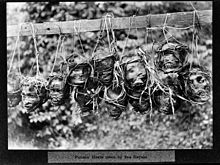
In Sarawak, the north-western region of the island of Borneo, the first "White Rajah" James Brooke and his descendants established a dynasty. They eradicated headhunting in the hundred years before World War II. Before Brooke's arrival, the Iban had migrated from the middle Kapuas region into the upper Batang Lupar river region by fighting and displacing the small existing tribes, such as the Seru and Bukitan. Another successful migration by the Iban was from the Saribas region into the Kanowit area in the middle of the Batang Rajang river, led by the famous Mujah "Buah Raya". They fought and displaced such tribes as the Kanowit and Baketan.[citation needed]
Brooke first encountered the headhunting Iban of the Saribas-Skrang in Sarawak at the Battle of Betting Maru in 1849. He gained the signing of the Saribas Treaty with the Iban chief of that region, who was named Orang Kaya Pemancha Dana "Bayang". Subsequently, the Brooke dynasty expanded their territory from the first small Sarawak region to the present-day state of Sarawak. They enlisted the Malay, Iban, and other natives as a large unpaid force to defeat and pacify any rebellions in the states. The Brooke administration prohibited headhunting (ngayau in Iban language) and issued penalties for disobeying the Rajah-led government decree. During expeditions sanctioned by the Brooke administration, they allowed headhunting. The natives who participated in Brooke-approved punitive expeditions were exempted from paying annual tax to the Brooke administration and/or given new territories in return for their service. There were intra-tribal and intertribal headhunting.[citation needed]
The most famous Iban warrior to resist the authority of the Brooke administration was Libau "Rentap". The Brooke government had to send three successive punitive expeditions in order to defeat Rentapi at his fortress on the top of Sadok Hill. Brooke's force suffered major defeats during the first two expeditions. During the third and final expedition, Brooke built a large cannon called Bujang Sadok (Prince of Sadok Mount) to rival Rentap's cannon nicknamed Bujang Timpang Berang (The One Arm Bachelor) and made a truce with the sons of a famous chief, who supported Rentap in not recognizing the government of Brooke due to his policies.[citation needed]
The Iban performed a third major migration from upper Batang Ai region in the Batang Lupar region into the Batang Kanyau (Embaloh) onwards the upper Katibas and then to the Baleh/Mujong regions in the upper Batang Rajang region. They displaced the existing tribes of the Kayan, Kajang, Ukit, etc. The Brooke administration sanctioned the last migrations of the Iban, and reduced any conflict to a minimum. The Iban conducted sacred ritual ceremonies with special and complex incantations to invoke god's blessings, which were associated with headhunting. An example was the Bird Festival in the Saribas/Skrang region and Proper Festival in the Baleh region, both required for men of the tribes to become effective warriors.[citation needed]
During the Japanese occupation of British Borneo during the Second World War, headhunting was revived among the natives. The Sukarno-led Indonesian forces fought against the formation of the Federation of Malaysia. Forces of Malaya, Singapore, Sabah and Sarawak fought in addition, and headhunting was observed during the communist insurgency in Sarawak and what was then Malaya. The Iban were noted for headhunting, and were later recognised as good rangers and trackers during military operations, during which they were awarded fourteen medals of valour and honour.[citation needed]
Since 1997 serious inter-ethnic violence has erupted on the island of Kalimantan, involving the indigenous Dayak peoples and immigrants from the island of Madura. Events have included the Sambas riots and Sampit conflict. In 2001, during the Sampit conflict in the Central Kalimantan town of Sampit, at least 500 Madurese were killed and up to 100,000 Madurese were forced to flee. Some Madurese bodies were decapitated in a ritual reminiscent of the Dayak headhunting tradition.[6]
The Moluccans (especially Alfurs in Seram), an ethnic group of mixed Austronesian-Papuan origin living in the Maluku Islands, were fierce headhunters until the Dutch colonial rule in Indonesia suppressed the practice.[7]
Melanesia
[edit]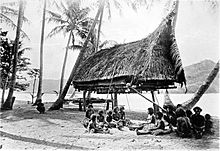
Headhunting was practiced by many Austronesian people in Southeast Asia and the Pacific Islands. Headhunting has at one time or another been practiced among most of the peoples of Melanesia,[8] including New Guinea.[9] A missionary found 10,000 skulls in a community longhouse on Goaribari Island in 1901.[10]
Historically, the Marind-anim in New Guinea were famed because of their headhunting.[11] The practice was rooted in their belief system and linked to the name-giving of the newborn.[12] The skull was believed to contain a mana-like force.[13] Headhunting was not motivated primarily by cannibalism, but the dead person's flesh was consumed in ceremonies following the capture and killing.[14]
The Korowai, a Papuan tribe in the southeast of Irian Jaya, live in tree houses, some nearly 40 metres (100') high. This was originally believed to be a defensive practice, presumably as protection against the Citak, a tribe of neighbouring headhunters.[15] Some researchers believe that the American Michael Rockefeller, who disappeared in New Guinea in 1961 while on a field trip, may have been taken by headhunters in the Asmat region. He was the son of New York Governor Nelson Rockefeller.
In The Cruise of the Snark (1911), the account by Jack London of his 1905 adventure sailing in Micronesia, he recounted that headhunters of Malaita attacked his ship during a stay in Langa Langa Lagoon, particularly around Laulasi Island. His and other ships were kidnapping villagers as workers on plantations, a practice known as blackbirding. Captain Mackenzie of the ship Minolta was beheaded by villagers as retribution for the loss of village men during an armed labour "recruiting" drive. The villagers believed that the ship's crew "owed" several more heads before the score was even.[16]
New Zealand
[edit]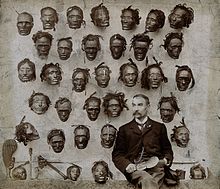
In New Zealand, the Maori preserved the heads of some of their ancestors as well as certain enemies in a form known as mokomokai. They removed the brain and eyes, and smoked the head, preserving the moko tattoos. The heads were sold to European collectors in the late 1800s, in some instances having been commissioned and "made to order".[17]
Philippines
[edit]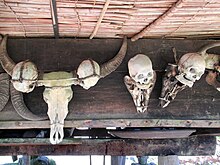
In the Philippines, headhunting was extensive among the various Cordilleran peoples (also known as "Igorot") of the Luzon highlands. It was tied with rites of passage, rice harvests, religious rituals to ancestor spirits, blood feuds, and indigenous tattooing. Cordilleran tribes used specific weapons for beheading enemies in raids and warfare, specifically the uniquely shaped head axes and various swords and knives. Though some Cordilleran tribes living near Christianized lowlanders during the Spanish colonial period had already abandoned the practice by the 19th century, they were still rampant in more remote areas beyond the reach of Spanish colonial authorities. The practices were finally suppressed in the early 20th century by the United States during the American colonial period of the Philippines.[18]
Taiwan
[edit]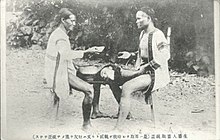
Headhunting was a common practice among Taiwanese aborigines. All tribes practiced headhunting except the Yami people, who were previously isolated on Orchid Island, and the Ivatan people. It was associated with the peoples of the Philippines.
Taiwanese Plains Aborigines, Han Taiwanese and Japanese settlers were choice victims of headhunting raids by Taiwanese Mountain Aborigines. The latter two groups were considered invaders, liars, and enemies. A headhunting raid would often strike at workers in the fields, or set a dwelling on fire and then kill and behead those who fled from the burning structure. The practice continued during the Japanese rule of Taiwan, but ended in the 1930s due to brutal suppression by the Japanese colonial government.
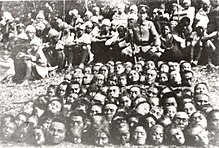
The Taiwanese Aboriginal tribes, who were allied with the Dutch against the Chinese during the Guo Huaiyi Rebellion in 1652, turned against the Dutch in turn during the Siege of Fort Zeelandia. They defected to Koxinga's Chinese forces.[19] The Aboriginals (Formosans) of Sincan defected to Koxinga after he offered them amnesty. The Sincan Aboriginals fought for the Chinese and beheaded Dutch people in executions. The frontier aboriginals in the mountains and plains also surrendered and defected to the Chinese on May 17, 1661, celebrating their freedom from compulsory education under Dutch rule. They hunted down Dutch people, beheading them and trashing their Christian school textbooks.[20]
At the Battle of Tamsui in the Keelung Campaign during the Sino-French War on 8 October 1884, the Chinese took prisoners and beheaded 11 French marines who were injured, in addition to La Galissonnière's captain Fontaine. The heads were mounted on bamboo poles and displayed to incite anti-French feelings. In China, pictures of the beheading of the Frenchmen were published in the Tien-shih-tsai Pictorial Journal in Shanghai.[21]
A most unmistakable scene in the market place occurred. Some six heads of Frenchmen, heads of the true French type were exhibited, much to the disgust of foreigners. A few visited the place where they were stuck up, and were glad to leave it—not only on account of the disgusting and barbarous character of the scene, but because the surrounding crowd showed signs of turbulence. At the camp also were eight other Frenchmen's heads, a sight which might have satisfied a savage or a Hill-man, but hardly consistent with the comparatively enlightened tastes, one would think, of Chinese soldiers even of to-day. It is not known how many of the French were killed and wounded; fourteen left their bodies on shore, and no doubt several wounded were taken back to the ships. (Chinese accounts state that twenty were killed and large numbers wounded.)
In the evening Captain Boteler and Consul Frater called on General Sun, remonstrating with him on the subject of cutting heads off, and allowing them to be exhibited. Consul Frater wrote him a despatch on the subject strongly deprecating such practices, and we understand that the general promised it should not occur again, and orders were at once given to bury the heads. It is difficult for a general even situated as Sun is—having to command troops like the Hillmen, who are the veriest savages in the treatment of their enemies—to prevent such barbarities.
It is said the Chinese buried the dead bodies of the Frenchmen after the engagement on 8th instant by order of General Sun. The Chinese are in possession of a machine gun taken or found on the beach.
— James Wheeler Davidson, The Island of Formosa, Past and Present: History, people, resources, and commercial prospects. Tea, camphor, sugar, gold, coal, sulphur, economical plants, and other productions[22]
Han Taiwanese and Taiwanese Aboriginals revolted against the Japanese in the Beipu Uprising in 1907 and Tapani Incident in 1915. The Seediq aboriginals revolted against the Japanese in the 1930 Musha Incident and resurrected the practice of headhunting, beheading Japanese during the revolt.
Mainland Asia
[edit]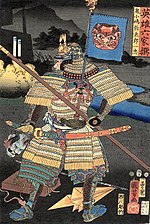
China
[edit]During the Spring and Autumn period and Warring States period, Qin soldiers frequently collected their defeated enemies' heads as a means to accumulate merits. After Shang Yang's reforms, the Qin armies adopted a meritocracy system that awards the average soldiers, most of whom were conscripted serfs and were not paid, an opportunity to earn promotions and rewards from their superiors by collecting the heads of enemies, a type of body count. In this area, authorities also displayed heads of executed criminals in public spaces up to the early 20th century.
The Wa people, a mountain ethnic minority in Southwest China, eastern Myanmar (Shan State) and northern Thailand, were once known as the "Wild Wa" by British colonists due to their traditional practice of headhunting.[23]
Japan
[edit]Tom O'Neill wrote:
Samurai also sought glory by headhunting. When a battle ended, the warrior, true to his mercenary origins, would ceremoniously present trophy heads to a general, who would variously reward him with promotions in rank, gold or silver, or land from the defeated clan. Generals displayed the heads of defeated rivals in public squares.[24]
Indian subcontinent and Indochina
[edit]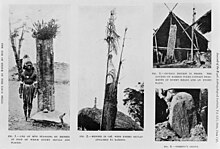
Headhunting has been a practice among the Kukis,[25] the Wa,[23] Mizo, the Garo and the Naga ethnic groups of India, Bangladesh and Myanmar till the 19th century.[26] Nuristanis in eastern Afghanistan were headhunters until the late 19th century.[25]
The Wa people, whose domain straddles the Burma-China border, were once known to Europeans as the "Wild Wa" for their "savage" behavior. Until the 1970s, the Wa practiced headhunting.[27]
Americas
[edit]Amazon
[edit]
Several tribes of the Jivaroan group, including the Shuar in Eastern Ecuador and Northern Peru, along the rivers Chinchipe, Bobonaza, Morona, Upano, and Pastaza, main tributaries of the Amazon, practiced headhunting for trophies. The heads were shrunk, and were known locally as Tzan-Tzas. The people believed that the head housed the soul of the person killed.
In the 21st century, the Shuar produce Tzan-tza replicas. They use their traditional process on heads of monkeys and sloths, selling the items to tourists. It is believed that splinter groups in the local tribes continue with these practices when there is a tribal feud over territory or as revenge for a crime of passion. [citation needed]
The Kichwa-Lamista people in Peru used to be headhunters.[28]
Mesoamerican civilizations
[edit]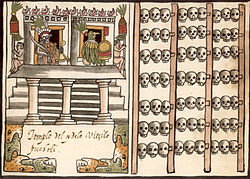
A tzompantli is a type of wooden rack or palisade documented in several Mesoamerican civilizations. It was used for the public display of human skulls, typically those of war captives or other sacrificial victims.[29]
A tzompantli-type structure has been excavated at the La Coyotera, Oaxaca site. It is dated to the Proto-Classic Zapotec civilization, which flourished from c. 2nd century BCE to the 3rd century CE.[30] Tzompantli are also noted in other Mesoamerican pre-Columbian cultures, such as the Toltec and Mixtec.
Based on numbers given by the conquistador Andrés de Tapia and Fray Diego Durán, Bernard Ortiz de Montellano[31] has calculated in the late 20th century that there were at most 60,000 skulls on the Hueyi Tzompantli (great Skullrack) of Tenochtitlan. There were at least five more skullracks in Tenochtitlan, but, by all accounts, they were much smaller.
Other examples are indicated from Maya civilization sites. A particularly fine and intact inscription example survives at the extensive Chichen Itza site.[32]
Nazca culture
[edit]The Nazca used severed heads, known as trophy heads, in various religious rituals.[33] Late Nazca iconography suggests that the prestige of the leaders of Late Nazca society was enhanced by successful headhunting.[34]
Europe
[edit]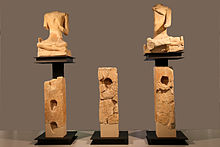
Celts
[edit]The Celts of Europe practiced headhunting as the head was believed to house a person's soul. Ancient Romans and Greeks recorded the Celts' habits of nailing heads of personal enemies to walls or dangling them from the necks of horses.[35] The Celtic Gaels practiced headhunting a great deal longer. In the Ulster Cycle of Irish mythology, the demigod Cúchulainn beheads the three sons of Nechtan and mounting their heads on his chariot. This is believed to have been a traditional warrior, rather than religious, practice. The practice continued approximately to the end of the Middle Ages among the Irish clans and even later among the Border Reivers of the Anglo-Scottish marches.[36] The pagan religious reasons for headhunting were likely lost after the Celts' conversion to Christianity, even though the practice continued.[citation needed] In former Celtic areas, cephalophore representations of saints (miraculously carrying their severed heads) were common.[37] Heads were also taken among the Germanic tribes and among Iberians, but the purpose is unknown.
Scythians
[edit]The Scythians were excellent horsemen. Ancient Greek historian Herodotus wrote that some of their tribes practiced human sacrifice, drinking the blood of victims, scalping their enemies, and drinking wine from the enemies' skulls.[38]
Montenegrins
[edit]The Montenegrins are an ethnic group in Southeastern Europe who are centered around the Dinaric mountains. They practiced headhunting until 1876, allegedly carrying the head from a lock of hair grown specifically for that purpose.[39] In the 1830s, Montenegrin ruler Petar II Petrović-Njegoš started building a tower called "Tablja" above Cetinje Monastery. The tower was never finished, and Montenegrins used it to display Turkish heads taken in battle, as they were in frequent conflict with the Ottoman Empire. In 1876 King Nicholas I of Montenegro ordered that the practice should end. He knew that European diplomats considered it to be barbaric. The Tablja was demolished in 1937.
Modern times
[edit]
Second Sino-Japanese War
[edit]Nanjing Massacre
[edit]Many Chinese soldiers and civilians were beheaded by some Japanese soldiers, who even made contests to see who would kill more people (see Hundred man killing contest), and took photos with the piles of heads as souvenirs.
World War II
[edit]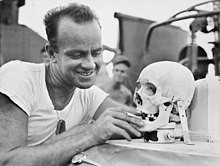
During World War II, Allied (specifically including American) troops occasionally collected the skulls of dead Japanese as personal trophies, as souvenirs for friends and family at home, and for sale to others. (The practice was unique to the Pacific theater; United States forces did not take skulls of German and Italian soldiers.) In September 1942, the Commander in Chief of the Pacific Fleet mandated strong disciplinary action against any soldier who took enemy body parts as souvenirs. But such trophy-hunting persisted: Life published a photograph in its issue of May 22, 1944, of a young woman posing with the autographed skull sent to her by her Navy boyfriend. There was public outrage in the US in response.[40][41]
Historians have suggested that the practice related to Americans viewing the Japanese as lesser people, and in response to mutilation and torture of American war dead.[42] In Borneo, retaliation by natives against the Japanese was based on atrocities having been committed by the Imperial Japanese Army in that area. Following their ill treatment by the Japanese, the Dayak of Borneo formed a force to help the Allies. Australian and British special operatives of Z Special Unit developed some of the inland Dayak tribesmen into a thousand-strong headhunting army. This army of tribesmen killed or captured some 1,500 Japanese soldiers.[43]

Malayan Emergency
[edit]During the Malayan Emergency (1948–1960), British and Commonwealth forces recruited Iban (Dayak) headhunters from Borneo to fight and decapitate suspected guerrillas of the socialist and pro-independence Malayan National Liberation Army, officially claiming this was done for "identification" purposes.[44] Iban headhunters were permitted to keep the scalps of corpses as trophies.[45][44] Privately, the Colonial Office noted that "there is no doubt that under international law a similar case in wartime would be a war crime".[46][47][48] Skull fragments from a trophy skull was later found to have been displayed in a British regimental museum.[44]
In April 1952, the British Communist Party's official newspaper the Daily Worker (today known as the Morning Star) published a photograph of Royal Marines in a British military base in Malaya openly posing with severed human heads.[44][49] Initially, British government spokespersons belonging to the Admiralty and the Colonial Office denied the newspaper's claims and insisted that the photograph was a forgery.[48] In response, the Daily Worker released yet another photograph taken in Malaya showing other British soldiers posing with a severed human head. In response, Colonial Secretary Oliver Lyttelton was forced to admit before the House of Commons that the Daily Worker headhunting photographs were indeed genuine.[50] In response to the Daily Worker articles, headhunting was banned by Winston Churchill, who feared that further photographs would continue being exploited for communist propaganda.[44][51]
Despite the shocking imagery of the photographs of soldiers posing with severed heads in Malaya, the Daily Worker was the only British newspaper to publish them during the 20th century, and the photographs were virtually ignored by the mainstream British press.[48]
-
An Iban headhunter wearing a Royal Marine beret prepares a human scalp above a basket of human body parts.
-
An Iban headhunter posing with a human scalp
-
The Daily Worker exposes the practice of headhunting among British troops in Malaya. 28 April 1952.
-
Commonwealth soldiers pose with a severed head inside a British military base in Malaya during the Malayan Emergency
-
Two corpses and a severed head belonging to guerrillas killed by the Queen's Own Royal West Kent Regiment.
-
Atrocity photographs (including headhunting) from the archives of the Working Class Movement Library, Manchester.
-
Decapitated head of MNLA guerrilla commander Hen Yan, killed in 1952 by the Suffolk Regiment.
-
Photographs of decapitated MNLA member held in the archives of the National Army Museum, London.
-
Anti-war leaflet published in 1952 protesting British headhunting in Malaya
Vietnam War
[edit]During the Vietnam War, some American soldiers engaged in the practice of taking "trophy skulls".[52][53]
Gallery
[edit]-
Head trophy, Munduruku people, northern Brazil, c. 1820
-
Seh-Dong-Hong-Beh, leader of the Dahomey Amazons, holding a severed head.
-
An Ifugao warrior with some of his trophies, Philippines, 1912
-
Dayak women dancing with human heads, 1912
-
The Dayak longhouse
-
Japanese samurai holding a severed head
-
Severed heads of bandits Tieling, Manchuria in 1928, during the government of Zhang Xueliang
See also
[edit]- Shrunken head
- Scalping
- Decapitation
- Skull cup
- Human sacrifice
- Human trophy collecting
- Macheteros de Jara
- Laulasi Island
- Beheading in Islam
- Headless Horseman
- Plastered human skulls
- Crypteia, a Spartan organization who routinely practised headhunting against the servile Helot population.
- Tribal warfare
References
[edit]Citations
[edit]- ^ a b Modigliani, Elio (1890). Un viaggio a Nias [A Journey to Nias] (in Italian). Milano: Fratelli Treves Editori.
- ^ Hutton, J. H. "The Significance of Head-Hunting in Assam." The Journal of the Royal Anthropological Institute of Great Britain and Ireland, vol. 58, 1928, pp. 399–408.
- ^ DeMello, Margo (2014). Inked: Tattoos and Body Art around the World. Vol. 1. ABC-CLIO. pp. 272–274. ISBN 978-1-61069-076-8. Archived from the original on July 26, 2020. Retrieved June 4, 2020.
- ^ Puccioni, Vanni. (2013). Fra i tagliatori di teste : Elio Modigliani : un fiorentino all'esplorazione di Nias Salatan, 1886. Marsilio. ISBN 978-88-317-1710-6. OCLC 909365265.
- ^ Hoskins, Janet. The Play of Time: Kodi Perspectives on Calendars, History, and Exchange. Berkeley: University of California Press, c1993 1993. http://ark.cdlib.org/ark:/13030/ft0x0n99tc/ p.312-314
- ^ "Behind Ethnic War, Indonesia's Old Migration Policy". Globalpolicy.org. March 1, 2001. Retrieved May 25, 2010.
- ^ Bartels, Dieter. "Politicians and Magicians: Power, Adaptive Strategies, and Syncretism in the Central Moluccas" (PDF). Retrieved February 8, 2024.
- ^ Van Der Kroef, Justus M. (1952). "Some Head-Hunting Traditions of Southern New Guinea". American Anthropologist. 54 (2): 221–235. doi:10.1525/aa.1952.54.2.02a00060. JSTOR 663912.
- ^ "Hunter Gatherers – New Guinea". Climatechange.umaine.edu. Archived from the original on August 1, 2012. Retrieved May 25, 2010.
- ^ Laurence Goldman (1999).The Anthropology of Cannibalism. p.19.
- ^ Nevermann 1957, p. 9.
- ^ Nevermann 1957, p. 111.
- ^ Nevermann 1957, blurb.
- ^ Nevermann 1957, p. 13.
- ^ "Head-Hunters Drove Papuan Tribe Into Tree-Houses". Sciencedaily.com. March 9, 1998. Retrieved May 25, 2010.
- ^ Jack London (1911). The Cruise of the Snark. Harvard University Digitized Jan 19, 2006.
- ^ "Weather delays return of toi-moko", TNVZ (national news)
- ^ Worcester, Dean C. (October 1906). "The Non-Christian Tribes of Northern Luzon". The Philippine Journal of Science. 1 (8): 791–875.
- ^ Covell, Ralph R. (1998). Pentecost of the Hills in Taiwan: The Christian Faith Among the Original Inhabitants (illustrated ed.). Hope Publishing House. pp. 96–97. ISBN 0932727905. Retrieved December 10, 2014.
- ^ Hsin-Hui, Chiu (2008). The Colonial 'civilizing Process' in Dutch Formosa: 1624 - 1662. Vol. 10 of TANAP monographs on the history of the Asian-European interaction (illustrated ed.). BRILL. p. 222. ISBN 978-9004165076. Retrieved December 10, 2014.
- ^ Maritime Taiwan. M.E. Sharpe. ISBN 9780765641892.
- ^ Davidson, James Wheeler (1903). The Island of Formosa, Past and Present. Macmillan & Company.
- ^ a b "Headhunting days are over for Myanmar's 'Wild Wa'". Reuters. September 10, 2007. Archived from the original on May 27, 2018. Retrieved July 5, 2021.
- ^ Tom O'Neill, "Samurai: Japan's Way of the Warrior", National Geographic Magazine.
- ^ a b "Headhunting (anthropology)". Encyclopaedia Britannica.
- ^ Crudelli, Chris (October 1, 2008). The Way of the Warrior. Dorling Kindersley. p. 23. ISBN 978-1405330954.
- ^ "Soldiers of Fortune", TIME Asia
- ^ Hsu, Elisabeth; Harris, Stephen (May 15, 2012). Plants, Health And Healing. Berghahn Books. ISBN 9780857456342.
- ^ "Tower of human skulls in Mexico casts new light on Aztecs". Reuters. July 1, 2017.
- ^ Spencer 1982, pp. 236–239.
- ^ Ortíz de Montellano 1983.
- ^ Miller & Taube 1993, p. 176.
- ^ "The Body Context: Interpreting Early Nasca Decapitation Burials" DeLeonardis, Lisa. Latin American Antiquity. 2000. Vol. 11, No. 4, pp. 363–368.
- ^ "A Cache of 48 Nasca Trophy Heads From Cerro Carapo, Peru" by David Browne, Helaine Silverman, and Ruben Garcia, Latin American Antiquity (1993), Volume 4, No. 3: 274–294
- ^ see e.g. Diodorus Siculus, 5.2
- ^ "Info for Headhunters". www.lard.net.
- ^ "The stories of St. Edmund, St. Kenelm, St. Osyth, and St. Sidwell in England, St. Denis in France, St. Melor and St. Winifred in Celtic territory, preserve the pattern and strengthen the link between legend and folklore," Beatrice White observes. (White 1972, p. 123).
- ^ Jona Lendering. "Summary of and commentary on Herodotus' Histories, book 4". Livius.org. Retrieved May 25, 2010.
- ^ Edith Durham, M. (December 24, 2004). Albania and the Albanians. Bloomsbury Academic. ISBN 9781850439394.
- ^ Fussell 1990, p. 117.
- ^ Harrison 2006, p. 817ff.
- ^ Weingartner 1992, p. 67.
- ^ "'Guests' can succeed where occupiers fail", International Herald Tribune, 9 November 2007
- ^ a b c d e Harrison, Simon (2012). Dark Trophies: Hunting and the Enemy Body in Modern War. Oxford: Berghahn. p. 158. ISBN 978-1-78238-520-2.
- ^ Hack 2022, p. 318.
- ^ Fujio Hara (December 2002). Malaysian Chinese & China: Conversion in Identity Consciousness, 1945–1957. University of Hawaii Press. pp. 61–65.
- ^ Mark Curtis (August 15, 1995). The Ambiguities of Power: British Foreign Policy Since 1945. pp. 61–71.
- ^ a b c Hack 2022, p. 316.
- ^ Hack 2022, p. 315.
- ^ Peng, Chin; Ward, Ian; Miraflor, Norma (2003). Alias Chin Peng: My Side of History. Singapore: Media Masters. p. 302. ISBN 981-04-8693-6.
- ^ Hack 2022, p. 317.
- ^ Michelle Boorstein (July 3, 2007). "Eerie Souvenirs From the Vietnam War". Washingtonpost.com. Retrieved June 26, 2010.
- ^ "Signs of the Times – Trophy Skulls". George.loper.org. August 8, 1996. Archived from the original on October 4, 2009. Retrieved May 25, 2010.
Sources
[edit]- Davidson, James Wheeler (1903). The Island of Formosa: Past and Present: History, People, Resources, and Commercial Crospects. Tea, Camphor, Sugar, Gold, Coal, Sulphur, Economical Plants, and other Productions. London and New York: Macmillan & Co.
- Davidson, James Wheeler (1903). The Island of Formosa: Historical View From 1430 to 1900.
- Fussell, Paul (1990). Wartime: Understanding and Behavior in the Second World War. New York: Oxford University Press. ISBN 9780199840359.
- George, Kenneth (1996). Showing Signs of Violence: The Cultural Politics of a Twentieth-Century Headhunting Ritual. Berkeley: University of California Press. ISBN 0-520-20041-1.
- Hack, Karl (2022). The Malayan Emergency: Revolution and Counterinsurgency at the End of Empire. Cambridge: Cambridge University Press.
- Harrison, Simon (2006). "Skull Trophies of the Pacific War: Transgressive Objects of remembrance". Journal of the Royal Anthropological Institute. 12 (4): 817-836. doi:10.1111/j.1467-9655.2006.00365.x.
- Miller, Mary; Taube, Karl (1993). The Gods and Symbols of Ancient Mexico and the Maya: An Illustrated Dictionary of Mesoamerican Religion. London: Thames and Hudson. ISBN 0-500-05068-6. OCLC 27667317.
- Nevermann, Hans (1957). Söhne des tötenden Vaters. Dämonen- und Kopfjägergeschichten aus Neu-Guinea [Sons of the killing father. Stories about demons and headhunting, recorded in New Guinea]. Das Gesicht der Völker (in German). Vol. 23. Eisenach • Kassel: Erich Röth-Verlag.
- Ortíz de Montellano, Bernard R. (1983). "Counting Skulls: Comment on the Aztec Cannibalism Theory of Harner-Harris". American Anthropologist. 85 (2): 403–406. doi:10.1525/aa.1983.85.2.02a00130.
- Rubenstein, Steven L. (2006). "Circulation, Accumulation, and the Power of Shuar Shrunken Heads". Cultural Anthropology. 22 (3): 357–399. doi:10.1525/can.2007.22.3.357.
- Tsai, Shih-shan Henry (2009). Maritime Taiwan: Historical Encounters with the East and the West (illustrated ed.). M.E. Sharpe. ISBN 978-0765623287.
- Spencer, C. S. (1982). The Cuicatlán Cañada and Monte Albán: A Study of Primary State Formation. New York: Academic Press. ISBN 978-0-12-656680-2.
- Weingartner, James J. (1992). "Trophies of War: U.S. Troops and the Mutilation of Japanese War Dead, 1941–1945". Pacific Historical Review. 61 (1): 53–67. doi:10.2307/3640788. ISSN 0030-8684. JSTOR 3640788.
- White, Beatrice (Summer 1972). "A Persistent Paradox". Folklore. 83 (2): 122–131. doi:10.1080/0015587X.1972.9716461. PMID 11614481.
- Yamada, Hitoshi (2015). Religionsethnologie der Kopfjagd (in Japanese). Tokyo: Chikuma Shobo. ISBN 978-4480843050.
Further reading
[edit]- Head-Hunting Roman Cavalry - article about single combat and the taking of heads and scalps as trophies by Roman warriors
- Les Romains, chasseurs de têtes - paper by Jean-Louis Voisin about the Roman practice of head hunting
- Cornélis De Witt Willcox (1912). The head hunters of northern Luzon: from Ifugao to Kalinga, a ride through the mountains of northern Luzon : with an appendix on the independence of the Philippines. Vol. 31 of Philippine culture series. Franklin Hudson Publishing Co. ISBN 9781465502544. Retrieved April 24, 2014.



